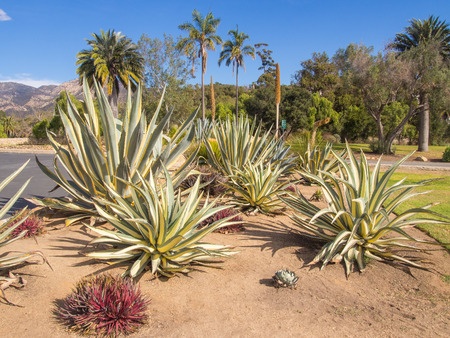
As one Chinese vlogger recently found out to her cost, not all plants are really food or that healthy. In fact the one she bit into, Agave americana L. (family: Agavaceae) is not as healthy as many of its relatives. It’s fair to say that of the 300 species in this family, there are quite a number which are not suitable for consumption although tequila is prepared from a few of them. For a start many contain calcium oxalate crystals which are highly toxic. A number of other plants such as Dumbcane or Dieffenbachia contain the same chemical and as the name suggests can render the biter speechless. The throat swells up, there is often a rash and severe reaction and in a few cases leads to death through asphyxiation.
The succulent is a native of Mexico but it’s also a plant found nowadays in Chinese herbals. All the ages inhabit the semi-arid regions of the world and are valuable for their horticultural benefits, providing fibre and tequila production. The sap from A. americana, according to the herbals is used as diuretic and laxative (JNMC, 1977).
Calcium oxalate is often found in foodstuffs and you can often find it as a crystalline precipitate in fruit juice beverages. It is however a necessary molecule when as oxalic acid in the TCA or Tricarboxylic Acid cycle which generates ATP and NADH as part of the cell’s metabolic pathway (simply put and could be more accurately made but it needs to be simple !)
As well as calcium oxalate, Agave Americana contains a variety of steroidal sapogenins or steroidal genins. One of these, hecogenin [(25R)-3β-hydroxy-5α-spirostan-12-one] forms when the leaf juice is treated with certain enzymes. These agents are reported to have anti-inflammatory benefits by reducing carrageenan generated oedema. They are also natural precursors for the production of a number of steroidal hormones (Peana et al., 1997). A few other saponins have been isolated, some of which have activity against some cancer cell lines (Yokosuka et al., 2000). Latterly, eight hecogenin glycosides were isolated from fermented leaves of the plant and found to have antifungal activity (Jin et al., 2010) and even block mycotoxin production (Rosas-Taraco et al., 2011).
A couple of novel flavonoids including 7-hydroxy-3-(4-methoxybenzyl)-chroman which is a homoisoflavonoid have been isolated (Tinto et al.,2005) as well as cantalasaponin-1 which is a saponin.
References
Jiangsu New Medical College (1977) in:. Dictionary of Chinese Medicinal Materials,. Vol. 1,: pp. 1414-5, Shanghai Scientific and Technological Press, Shanghai.
Jin, J. M., Liu, X. K., & Yang, C. R. (2003). Three new hecogenin glycosides from fermented leaves of Agave americana. Journal of Asian Natural Products Research, 5(2), pp. 95-103.
Peana, A. T., Moretti, M. D., Manconi, V., Desole, G., & Pippia, P. (1997). Anti-inflammatory activity of aqueous extracts and steroidal sapogenins of Agave americana. Planta medica, 63(03), pp. 199-202
Rosas-Taraco, A., Sanchez, E., García, S., Heredia, N., & Bhatnagar, D. (2011). Extracts of Agave americana inhibit aflatoxin production in Aspergillus parasiticus. World Mycotoxin Journal, 4(1), pp. 37-42.
Tinto, W. F., Simmons-Boyce, J. L., McLean, S., & Reynolds, W. F. (2005). Constituents of Agave americana and Agave barbadensis. Fitoterapia, 76(6), pp. 594-597. https://doi.org/10.1016/j.fitote.2005.04.013
Yokosuka, A., Mimaki, Y., Kuroda, M., & Sashida, Y. (2000). A new steroidal saponin from the leaves of Agave americana. Planta Medica, 66(04), pp. 393-396.

Leave a Reply